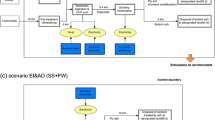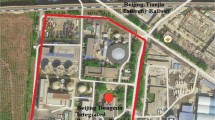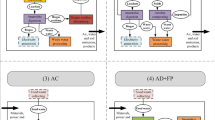Abstract
Food waste not only causes waste treatment loading but also leads to loss of resources. Food waste co-digestion with sewage sludge is regarded as one of the optimal technologies to treat food waste and for the recovery of bio-energy and phosphorus. Besides, focus on the recovery rate and efficiency, environmental impacts and other benefits should also be considered when a new technology or policy is evaluated. In this study, the economic and recycling benefits of such treatment technology were assessed in five different cities in Asia. The comprehensive economic assessment was based on life cycle assessment and three kinds of economic benefits, i.e., energy production, P recovery, and greenhouse gas emissions. Hence, the aim of this study is to show the differences in economic benefits from various treatment processes in five cities in Asia. The benefits of food waste co-digestion with sewage sludge were evident from the results of this study. The results indicated that new energy production always dominates the economic values while the economic value from P recovery was relatively low since the P fertilizers are not expensive in Asia. However, differences in economic values were considered for the different Asia cities.





Similar content being viewed by others
References
Food and Agriculture Organization of the United Nations (FAO) (2011) Global food losses and food waste—extent, causes and prevention. FAO, Rome
Food and Agriculture Organization of the United Nations (FAO) (2013) Food wastage footprint: impacts on natural resources. FAO, Rome
Chen P, Liu T-K, Yu, H-Y C J-L (2012) Assessment of coastal eutrophication in Taiwan. In: Proceedings of the 34th Ocean Engineering Conference in Taiwan, 6
Morero B, Groppelli E, Campanella EA (2015) Life cycle assessment of biomethane use in Argentina. Bioresour Technol 182:208–216. https://doi.org/10.1016/j.biortech.2015.01.077
Cordell D, Drangert J-O, White S (2009) The story of phosphorus: global food security and food for thought. Glob Environ Change 19:292–305. https://doi.org/10.1016/j.gloenvcha.2008.10.009
Smil V (2000) Phosphorus in the environment: natural flows and human interferences. Annu Rev Energy Environ 25:53–88. https://doi.org/10.1146/annurev.energy.25.1.53
Seyhan D (2009) Country-scale phosphorus balancing as a base for resources conservation. Resour Conserv Recycl 53:698–709. https://doi.org/10.1016/j.resconrec.2009.05.001
Liu SM, Zhang J, Li DJ (2004) Phosphorus cycling in sediments of the Bohai and Yellow Seas. Estuar Coast Shelf Sci 59:209–218. https://doi.org/10.1016/j.ecss.2003.08.009
Ragnarsdottir KV, Sverdrup HU, Koca D (2011) Challenging the planetary boundaries I: basic principles of an integrated model for phosphorous supply dynamics and global population size. Appl Geochem 26:S303–S306. https://doi.org/10.1016/j.apgeochem.2011.03.088
Linderholm K, Mattsson JE, Tillman AM (2012) Phosphorus flows to and from Swedish agriculture and food chain. Ambio 41:883–893. https://doi.org/10.1007/s13280-012-0294-1
Egle L, Zoboli O, Thaler S, Rechberger H, Zessner M (2014) The Austrian P budget as a basis for resource optimization. Resour Conserv Recycl 83:152–162. https://doi.org/10.1016/j.resconrec.2013.09.009
Woon KS, Lo IMC, Chiu SLH, Yan DYS (2016) Environmental assessment of food waste valorization in producing biogas for various types of energy use based on LCA approach. Waste Manag 50:290–299. https://doi.org/10.1016/j.wasman.2016.02.022
Lin CSK, Pfaltzgraff LH, Davila L, Mubofu E, Abderrahim S (2013) Food waste as a valuable resource for the production of chemicals, materials and fuels. Current situation and global perspective. Energy Environ Sci 6:426–464. https://doi.org/10.1039/C2EE23440H
Liu Y, Kumar S, Kwag J-H, Ra C (2013) Magnesium ammonium phosphate formation, recovery and its application as valuable resources: a review. J Chem Technol Biotechnol 88:181–189. https://doi.org/10.1002/jctb.3936
Shepherd JG, Sohi SP, Heal KV (2016) Optimising the recovery and re-use of phosphorus from wastewater effluent for sustainable fertiliser development. Water Res 94:155–165. https://doi.org/10.1016/j.watres.2016.02.038
Tarayre C, De Clercq L, Charlier R, Michels E, Meers E, Camargo-Valero M, Delvigne F (2016) New perspectives for the design of sustainable bioprocesses for phosphorus recovery from waste. Bioresour Technol 206:264–274. https://doi.org/10.1016/j.biortech.2016.01.091
Nakakubo T, Tokai A, Ohno K (2012) Comparative assessment of technological systems for recycling sludge and food waste aimed at greenhouse gas emissions reduction and phosphorus recovery. J Clean Prod 32:1. https://doi.org/10.1016/j.jclepro.2012.03.026
Cherubini F, Stromman AH (2011) Life cycle assessment of bioenergy systems: state of the art and future challenges. Bioresour Technol 102(2):437–451. https://doi.org/10.1016/j.biortech.2010.08.010
Food and Agriculture Organization of the United Nations(FAO) (2015) World fertilizer trends and outlook to 2018. FAO, Rome
Institute for Urban Strategies, The Mori Memorial Foundation (2017) Global power city index (GPCI). http://www.dianping.com.tw/download/151017k01.pdf. Accessed 15 Mar 2018
Kearney AT (2017) Global cities 2017. Leaders in a world of disruptive innovation. https://www.atkearney.com/documents/10192/12610750/Global+Cities+2017+-+Leaders+in+a+World+of+Disruptive+Innovation.pdf/c00b71dd-18ab-4d6b-8ae6-526e380d6cc4
Færge J, Magid J, Penning de Vries FWT (2001) Urban nutrient balance for Bangkok. Ecol Model 139:63–74. https://doi.org/10.1016/S0304-3800(01)00233-2
Liu TK, Chen P, Chen HY (2015) Comprehensive assessment of coastal eutrophication in Taiwan and its implications for management strategy. Mar Pollut Bull 97(1–2):440–450
Organisation for Economic Co-operation and Development (OECD) (2013) Southeast Asian economic outlook 2013: with perspectives on China and India. OECD Publishing, Paris. https://doi.org/10.1787/22253998
Singapore’s National Water Agency (2014) Innovation in water Singapore. https://www.pub.gov.sg/Documents/PUB_Innovation%20in%20Water%20Singapore%2008_web%20%2016%20June%202016.pdf. Accessed 15 Mar 2018
Jiang C (2011) A general investigation of Shanghai sewerage treatment system. Dissertation, Halmstad University
Pearce BJ, Chertow M (2017) Scenarios for achieving absolute reductions in phosphorus consumption in Singapore. J Clea Prod 140:1587–1601
Choy SY, Wang K, Qi W, Wang B, Chen CL, Wang JY (2015) Co-composting of horticultural waste with fruit peels, food waste, and soybean residues. Environ Technol 36(11):1448–1456
Liu Y, Kumar S, Kwag J-H, Ra C (2013) Magnesium ammonium phosphate formation, recovery and its application as valuable resources: a review. J Chem Technol Biotechnol 88(2):181–189. https://doi.org/10.1002/jctb.3936
Nakakubo T, Tokai A, Ohno K (2012) Comparative assessment of technological systems for recycling sludge and food waste aimed at greenhouse gas emissions reduction and phosphorus recovery. J Clean Prod 32:157–172
Zou H, Wang Y (2016) Phosphorus removal and recovery from domestic wastewater in a novel process of enhanced biological phosphorus removal coupled with crystallization. Bioresour Technol 211:87–92. https://doi.org/10.1016/j.biortech.2016.03.073
Bank W (2015) Carbon pricing watch 2015. http://documents.worldbank.org/curated/en/387741468188935412/Carbon-pricing-watch-2015-an-advance-brief-from-the-state-and-trends-of-carbon-pricing-2015-report-to-be-released-late-2015. Accessed 15 Mar 2018
Asmala E, Saikku L (2010) Closing a loop: substance flow analysis of nitrogen and phosphorus in the rainbow trout production and domestic consumption system in Finland. Ambio 39:126–135. https://doi.org/10.1007/s13280-010-0024-5
Kelessidis A, Stasinakis AS (2012) Comparative study of the methods used for treatment and final disposal of sewage sludge in European countries. Waste Manag 32(6):1186–1195
Yang G, Zhang G, Wang H (2015) Current state of sludge production, management, treatment and disposal in China. Water Res 78:60–73
Zhang Q, Hu J, Lee DJ, Chang Y, Lee YJ (2017) Sludge treatment: current research trends. Bioresour Technol 243:1159–1172
Tao J, Wu S, Sun L, Tan X, Yu S, Zhang Z (2012) Composition of waste sludge from municipal wastewater treatment plant. Procedia Environ Sci 12:964–971
Anjum M, Al-Makishah NH, Barakat MA (2016) Wastewater sludge stabilization using pre-treatment methods. Process Saf Environ Prot 102:615–632
Michael-Kordatou I, Michael C, Duan X, He X, Dionysiou DD, Mills MA, Fatta-Kassinos D (2015) Dissolved effluent organic matter: characteristics and potential implications in wastewater treatment and reuse applications. Water Res 77:213–248
Gao A, Tian Z, Wang Z, Wennersten R, Sun Q (2017) Comparison between the technologies for food waste treatment. Energy Procedia 105:3915–3921
Shin SG, Han G, Lee J, Cho K, Jeon EJ, Lee C, Hwang S (2015) Characterization of food waste-recycling wastewater as biogas feedstock. Bioresour Technol 196:200–208
Lee J, Han G, Shin SG, Koo T, Cho K, Kim W, Hwang S (2016) Seasonal monitoring of bacteria and archaea in a full-scale thermophilic anaerobic digester treating food waste-recycling wastewater: correlations between microbial community characteristics and process variables. Chem Eng J 300:291–299
Pham TPT, Kaushik R, Parshetti GK, Mahmood R, Balasubramanian R (2015) Food waste-to-energy conversion technologies: current status and future directions. Waste Manag 38:399–408
Kacprzak M, Neczaj E, Fijałkowski K, Grobelak A, Grosser A, Worwag M et al (2017) Sewage sludge disposal strategies for sustainable development. Environ Res 156:39–46
Osaka Population 2013. http://www.worldpopulationstatistics.com/osaka-population-2013/. Accessed 15 Mar 2018
Department of Budget, Accounting and Statistics, Taipei City Government (2015). http://physicsweb.org/articles/news/11/6/16/1. Accessed 26 June 2007
Development of Statistics Singapore (2018) Latest data. Government of Singapore. http://www.singstat.gov.sg/statistics/latest-data#1. Accessed 15 Mar 2018
Nation Environmental Agency of Singapore (2017) Waste statistics and overall recycling. Government of Singapore. http://www.nea.gov.sg/energy-waste/waste-management/waste-statistics-and-overall-recycling. Accessed 15 Mar 2018
Cumo F, Garcia DA, Calcagnini L, Cumo F, Rosa F, Sferra AS (2012) Urban policies and sustainable energy management. Sustain Cities Soc 4:29–34. https://doi.org/10.1016/j.scs.2012.03.003
Taiwan Power Company. http://www.taipower.com.tw/UpFile/_userfiles/file/2012年各國電價比.pdf. Accessed 15 Mar 2018
Author information
Authors and Affiliations
Corresponding author
Additional information
Publisher's Note
Springer Nature remains neutral with regard to jurisdictional claims in published maps and institutional affiliations.
Rights and permissions
About this article
Cite this article
Wang, YS., Kuo, NW. Economic assessment of food waste co-digestion with sewage sludge in five Asian cities. J Mater Cycles Waste Manag 21, 872–884 (2019). https://doi.org/10.1007/s10163-019-00844-2
Received:
Accepted:
Published:
Issue Date:
DOI: https://doi.org/10.1007/s10163-019-00844-2




